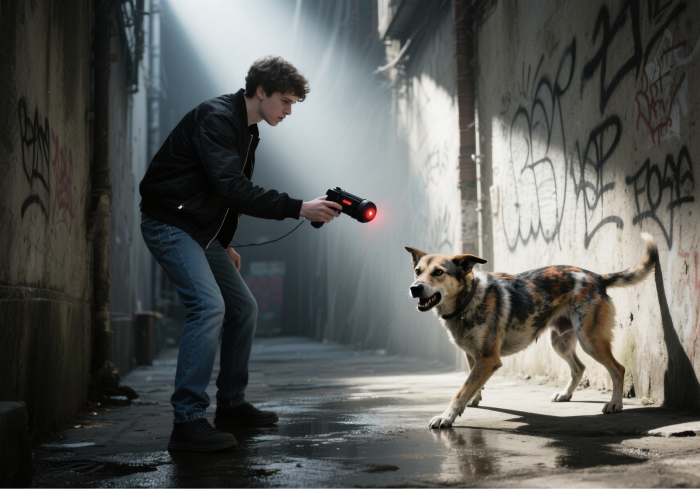
Working Principle:
Ultrasonic dog repellers utilize the canine sensitivity to high-frequency sound waves. By emitting specific frequencies, typically between 30kHz-50kHz, these devices irritate a dog’s auditory system, causing discomfort or avoidance responses while remaining inaudible to humans.
1. Canine Hearing vs. Ultrasonic Characteristics:
Human hearing range: 20Hz-20kHz
Canine hearing range: 15Hz-50kHz (some breeds up to 65kHz), with heightened sensitivity between 20kHz-45kHz.
Advantage: Ultrasonic frequencies (>20kHz) are beyond human hearing, enabling targeted repelling without disturbing people.
2. Dog Repelling Mechanism:
Frequency: Devices emit ultrasonic pulses (30kHz-50kHz), mimicking the high-frequency signals of predators or unpleasant sounds like fingernails scraping a blackboard.
Behavioral Response: Dogs may exhibit signs of irritation or fear (e.g., tail tucking, retreating) and avoid the sound source.
1. Core Components:
| Component | Description |
|---|---|
| Ultrasonic Transducer | Piezoelectric ceramic transducer emitting a specific frequency (e.g., 40kHz). |
| Control Circuit | Generates pulse signals, controls frequency, intensity, and emission intervals. |
| Sensor Module | Optional infrared or microwave sensors trigger automatic emission. |
| Power Supply | Typically lithium battery or solar-powered, with a battery life of several weeks. |
2. Operating Modes:
Active Repelling: Continuous or intermittent emission, creating a "sonic barrier" (e.g., mounted on fences to cover a 5-10m radius).
Passive Triggered: Emits sound when infrared/microwave sensors detect dog movement (e.g., near trash bins).
Adjustable Frequency: Switchable frequency modes (35kHz, 40kHz, 45kHz) to suit different breeds’ sensitivities.
1. Frequency Selection:
Common range: 30kHz-50kHz (targeting sensitive areas of canine hearing).
Considerations: To prevent habituation, the frequency should periodically switch within this range.
2. Sound Intensity Control:
Safety Threshold: Sound pressure level at 1 meter is typically kept between 80dB-100dB (equivalent to human shouting) to avoid harm.
Regulatory Compliance: Ensure compliance with local regulations (e.g., EU CE certification requires sound levels <110dB).
3. Directionality & Coverage:
Beam Angle: Narrow beam (30°-60°) design focuses energy, extending range up to 15-20m and minimizing unwanted interference.
Multi-Sensor Arrays: Multiple emitters (e.g., circular arrays) offer 360° coverage, ideal for yards or parking lots.
1. Home Protection:
Scenario: Prevent stray dogs from entering gardens or damaging lawns.
Solution: Install infrared-triggered ultrasonic repellers on fences or doorways.
Product Example: PetSafe Ultrasonic Dog Repeller (10m coverage, battery/pluggable modes).
2. Portable Devices:
Scenario: Keep wild dogs away during hiking or camping.
Solution: Handheld repellers with a button-triggered ultrasonic emission and an optional LED light for added deterrence.
Product Example: Guardian Angel Ultrasonic Dog Repeller (flashlight-sized, 8m range).
3. Public Space Protection:
Scenario: Prevent dogs from marking tires, power poles, or trash bins.
Solution: Attach small ultrasonic emitters to surfaces (e.g., on vehicles) using adhesive.
Product Example: Sanko Ultrasonic Dog Repeller Stickers (uses vehicle vibrations to activate sound).
1. Effectiveness Influencing Factors:
Breed & Individual Differences: Younger or more sensitive dogs (e.g., German Shepherds) react strongly, while older or hearing-impaired dogs may be unaffected.
Environmental Interference: Background noise (e.g., traffic) may reduce effectiveness; ensure signal-to-noise ratio is >10dB.
Usage Duration: Initial effectiveness is high, but prolonged use may lead to habituation; alternating activation modes are recommended.
2. Ethical & Legal Concerns:
Animal Welfare: Some animal rights organizations argue that ultrasonic devices cause psychological stress, advocating for alternative methods like scent-based repellents.
Legal Restrictions: In some regions (e.g., UK), ultrasonic dog repellers are banned in public spaces, requiring legal compliance.
1. Safety Recommendations:
Avoid direct exposure to dogs within 1 meter to prevent hearing damage.
Use with caution around pregnant women or individuals with heart conditions (although the frequency does not affect human hearing, it may cause discomfort for some).
Contact Us
If you have any questions about our products and services, please fill out the form and contact us.